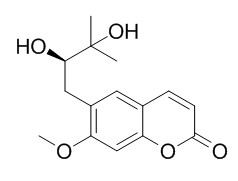Peucedanol
(R)-peucedanol has radical scavenging on 1,1-diphenyl-2-picrylhydrazyl radical and for inhibition of oxidation of liposome induced by 2,2'-azobis(2-amidinopropane)
dihydrochloride, it may have antioxidant activity.
Inquire / Order:
manager@chemfaces.com
Technical Inquiries:
service@chemfaces.com
Tel:
+86-27-84237783
Fax:
+86-27-84254680
Address:
1 Building, No. 83, CheCheng Rd., Wuhan Economic and Technological Development Zone, Wuhan, Hubei 430056, PRC
Providing storage is as stated on the product vial and the vial is kept tightly sealed, the product can be stored for up to
24 months(2-8C).
Wherever possible, you should prepare and use solutions on the same day. However, if you need to make up stock solutions in advance, we recommend that you store the solution as aliquots in tightly sealed vials at -20C. Generally, these will be useable for up to two weeks. Before use, and prior to opening the vial we recommend that you allow your product to equilibrate to room temperature for at least 1 hour.
Need more advice on solubility, usage and handling? Please email to: service@chemfaces.com
The packaging of the product may have turned upside down during transportation, resulting in the natural compounds adhering to the neck or cap of the vial. take the vial out of its packaging and gently shake to let the compounds fall to the bottom of the vial. for liquid products, centrifuge at 200-500 RPM to gather the liquid at the bottom of the vial. try to avoid loss or contamination during handling.
Molecules.2023, 28(17):6315.
J Pharm Biomed Anal.2019, 164:119-127
Phytochem Anal.2016, 27(5):296-303
Cell.2018, 172(1-2):249-261
J of Apicultural Research2020, 10.1080
iScience.2024, 27(8):110496.
Rep.Grant.Res.,Asahi Glass Foun.2023, No.119.
Revista Brasileira de Farmacognosia2021, 31:794-804.
Molecules.2023, 28(8):3291.
Korean Herb. Med. Inf.2020, 8(2):205-213
Related and Featured Products
Molecules. 2015 Jun 25;20(7):11719-32.
Transport of Twelve Coumarins from Angelicae Pubescentis Radix across a MDCK-pHaMDR Cell Monolayer-An in Vitro Model for Blood-Brain Barrier Permeability.[Pubmed:
26121397]
Angelicae Pubescentis Radix (APR), a widely used traditional Chinese medicine, is reported to have central nervous system activities.
METHODS AND RESULTS:
The purpose of this study was to characterize the blood-brain barrier permeability of twelve coumarins from APR including umbelliferone (1), osthol (2), scopoletin (3), Peucedanol (4), ulopterol (5), angepubebisin (6), psoralen (7), xanthotoxin (8), bergapten (9), isoimperatorin (10), columbianadin (11), and columbianetin acetate (12) with an in vitro model using a MDCK-pHaMDR cell monolayer. The cell monolayer was validated to be suitable for the permeation experiments. The samples' transports were analyzed by high performance liquid chromatography and their apparent permeability coefficients (Papp) were calculated. According to the Papp value, most coumarins could be characterized as well-absorbed compounds except for 4, 10 and 11 which were moderately absorbed ones, in concentration-dependent and time-dependent manners. The results of P-glycoprotein (P-gp) inhibitor (verapamil) experiments showed that the transport of coumarin 4 was affected by the transport protein P-gp. Sigmoid functions between permeability log(Papp AP-BL*MW0.5) and log D (at pH 7.4) were established to analyze the structure-activity relationship of coumarins.
CONCLUSIONS:
The results provide useful information for discovering the substance basis for the central nervous system activities of APR, and predicting the permeability of other coumarins through BBB.
J Agric Food Chem. 2003 Aug 27;51(18):5255-61.
Antioxidant compounds from the leaves of Peucedanum japonicum thunb.[Pubmed:
12926867]
Seventeen compounds were isolated from the n-butanol soluble fraction of the leaves of Peucedanum japonicum Thunb.
METHODS AND RESULTS:
On the basis of MS and various NMR spectroscopic techniques, the structures of the isolated compounds were determined as isoquercitrin (1), rutin (2), 3-O-caffeoylquinic acid (3), 4-O-caffeoylquinic acid (4), 5-O-caffeoylquinic acid (5), cnidioside A (6), praeroside II (7), praeroside III (8), apterin (9), esculin (10), (R)-Peucedanol (11), (R)-Peucedanol 7-O-beta-d-glucopyranoside (12), l-tryptophan (13), uracil (14), guanosine (15), uridine (16), and thymidine (17). All compounds except 11 and 12 were isolated for the first time from P. japonicum. Several isolated compounds were quantified by high-performance liquid chromatography analysis. In addition, all isolated compounds were examined for radical scavenging on 1,1-diphenyl-2-picrylhydrazyl radical and for inhibition of oxidation of liposome induced by 2,2'-azobis(2-amidinopropane)dihydrochloride.
CONCLUSIONS:
Compounds 2-5 were found to be the major potent constituents, which contribute to the antioxidant activity of P. japonicum leaves.
J Asian Nat Prod Res. 2009 Aug;11(8):698-703.
Novel coumarin and furan from the roots of Angelica pubescens f. biserrata.[Pubmed:
20183310]
METHODS AND RESULTS:
A new natural coumarin, angepubebisin (1), and a new furan, angepubefurin (2), together with the five known compounds, umbelliferone, angelol B (3), ulopterol (4), Peucedanol (5), and scopoletin, were isolated from the roots of Angelica pubescens Maxim. f. biserrata Shan et Yuan.
CONCLUSIONS:
The structures of angepubebisin (1) and known compounds were determined by spectroscopic methods, including IR, UV, EI-MS, HR-FTICR-MS, 1D-, and 2D-NMR spectral analyses, and angepubefurin (2) was determined by HR-FTICR-MS and X-ray diffraction analyses.



